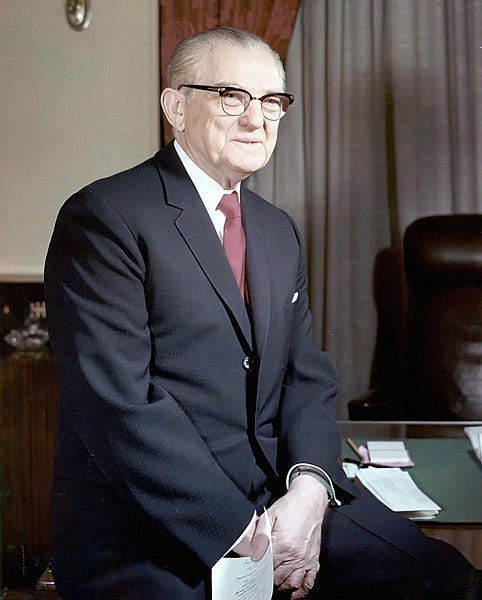The Southern Manifesto: Who didn't sign? And why?
In February 1956, a delegation of southern senators met in the office of Sen. Richard B. Russell of Georgia to draft a response to the Supreme Court’s decision on Brown v. Board of Education. By ruling school segregation unconstitutional, these senators—who were members of the Senate’s unofficial Southern Caucus—believed the Supreme Court had gone too far. As Senator John C. Stennis of Mississippi would put it later, “to charge the court with acting contrary to the Constitution is to say it went beyond its constitutional power and brands the decision as unconstitutional.” In other words, the Southern Caucus believed the Supreme Court had acted outside its scope of authority with Brown.
This is why they had decided to meet—to take action against the Court; to rouse white southerners to their cause; to defend segregation.
When it was all said and done, 19 Senators and 82 Representatives had signed the response. The Declaration of Constitutional Principals or, to use its more common name, the Southern Manifesto, would be read into the congressional record on March 12, 1956. Discussing the importance of the Manifesto, Sen. Stennis, talking to a reporter from the Jackson, MS Clarion-Ledger, said, “even though on previous occasions some individuals, notably Abraham Lincoln, have directed stronger criticism at the Supreme Court and its decisions, for the first time in our national history, 100 members of the Congress have jointly signed a severe indictment of the Court for its judicial legislation and usurpation of power.”
The Southern Manifesto aimed to call out the Court for this perceived unconstitutional behavior:
We regard the decision of the Supreme Court in the school cases as a clear abuse of judicial power. It climaxes a trend in the Federal judiciary undertaking to legislate, in derogation of the authority of Congress, and to encroach upon the reserved rights of the states and the people…
We decry the Supreme Court’s encroachments on rights reserved to the states and to the people, contrary to established law and to the constitution.
And, because the signers of the Southern Manifesto viewed Brown as unconstitutional, they made sure to “commend the motives of those states which have declared the intention to resist forced integration by any lawful means.” Given the white supremacist politics that ruled the Jim Crow South, it’s not surprising that the vast majority of southern Senators and Representatives signed the Manifesto.
What about the three southern senators who did not sign?
Lyndon B. Johnson of Texas who, at the time, was the Senate Majority leader wasn’t asked. And it’s unclear what would’ve happened had the drafters of the Manifesto asked him to sign his name. As historian Anthony Badger pointed out in the Journal of Policy History, “Johnson was following a delicate balancing act keeping his power base in Texas, retaining the support of the southern senators, yet trying to establish a record on civil rights that might win him northern support for a presidential bid.”
The other two senators who refused to sign the Manifesto were the two senators from Tennessee: Estes Kefauver and Albert Gore. Like Johnson, Kefauver was never asked. Here’s Badger again: “The manifesto was issued in the midst of Estes Kefauver’s battle in the Democratic primaries for the 1956 presidential nomination. As a southerner chasing national office, he had little choice but to denounce the manifesto. The drafters did not even bother to ask him to sign it.”
Gore also had national ambitions. He was after the 1956 vice-presidential nomination—which, by the way, would end up going to Kefauver. And even though Gore showed his support for civil rights by refusing to put his name on the Manifesto and by actively signing pieces of rights legislation like the Civil Rights Act of 1957, he would end up withholding his support from other legislative endeavors like the Civil Rights Act of 1964 and from amending the U.S. Constitution to eliminate the poll tax—thus leaving a mixed record.
The point here is this: the southern senators who refused to sign the Manifesto did so to protect their national ambitions, did so out of legal moderation (e.g., the law is the law and must be complied with), or did do out of both. What they weren’t doing was taking a strong stand against segregation or a stand for integration. As Badger made clear in his essay:
Most of the nonsigners recognized that the Brown decision was inevitable, that it was the law of the land, and outright defiance was futile, but few of them were in any hurry to give up the privileges of segregation and, like other moderates, they feared the power of white public segregationist opinion… They feared an aroused white citizenry. What Johnson, Kefauver, and Gore… objected to in the manifesto was the fact that it stirred up that white sentiment and created the false hope that the Court could be defied.
So, these southern moderates might not have signed the Manifesto. But their reluctance to sign the document didn’t mean they lobbied for compliance with Brown either. Instead, according to Badger, “their fatalism guaranteed the outcome they most feared: an enraged white public opinion that would listen to the demagogues and resist racial change.” And there were plenty of demagogues to hitchhike with as the white South traveled the road ahead.
More to come soon…
Primary Sources
Ray, Kay. “Manifesto Signed by 100 as Stennis Points to Strength.” Clarion-Ledger. March 13, 1956.
“Manifesto Text on Integration.” Clarion-Ledger. March 13, 1956.
Secondary Sources
Badger, Anthony. “The South Confronts the Court: The Southern Manifesto of 1956.” Journal of Policy History 20, no. 1 (2008): 126-142.


